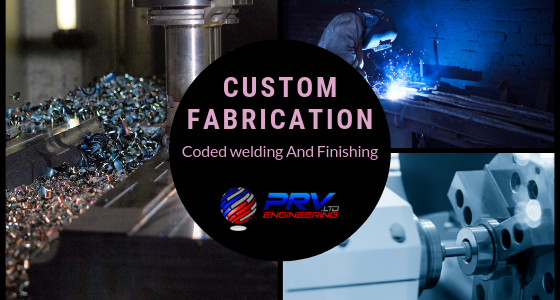An engineering company can only be successful with high-quality custom fabrication coupled with expert knowledge, experience and continuous investment. We’re not only talking about investing in equipment but also staff training and hiring. In order to provide the quality and service excellence customers deserve, equipment and staff must be of the highest level.
There are three core factors that determine success in manufacturing and that includes production cost, quality and speed. While each component plays a crucial role, manufacturers must fully commit to all three to reach and remain within the top tier.
Let’s take a look at some of the recent fabrication projects at PRV Engineering and find out more about coded welding and finishing.
Custom Fabrication At PRV Engineering
Over time PRV Engineering developed an extensive fabrication department capable of handling very small to much larger projects. This includes manufacturing simple and complex products to prototype testing and development. PRV provides high-quality custom fabrication and other services with a comprehensive portfolio of completed projects. We’ve listed a few below:
- Aluminium Framework
- Architectural Steel Fabrication
- Boat Cradles
- Canopies
- Catwalks
- Cover Plates
- Fabricated Brackets
- Fabricated assemblies
- Gravity Conveyor Systems
- Juliet Balconies
- Mezzanine Floors
- Roof Walkways
A Word From Simon Jones
In light of custom fabrication, Simon Jones, Managing Director at PRV Engineering said: “Our large format equipment allows us to machine large aluminium plates and structures as well as large steel components and structures. If somebody wants something made, we can make it and in any material from the most exotics to wood and plastic.”
What Is Coded Welding?
Coded Welding is also referred to as ”Code Welding” or “Welding Codes” which means the welder has taken an exam in a welding process for a specific method. Many say that the Welder Approval Test can is a little bit like learning to be a pilot. By no means do we compare it to flying an aeroplane but the test works the same way. Just like qualified pilots still need training on flying different planes, once you’re a qualified welder, you must also take type approval tests.
When deciding a welding code, you must consider the Process, Material, Thickness, Type of joint and Position (Difficulty). The position or difficulty is indicated by 1G – 6G where 1G is the easiest and 6G the most challenging.
Types Of Welding Codes
There are several welding codes such as BS 4872, BS EN 287-1, ASME IX and now EN ISO 9606-1.
- ASME IX (pronounced ‘asmey nine’) is an American qualification usually applicable to inclined pipe joints
- BS 4872 is the British Standards qualification and refers to plate work or beam welding joints (construction industry)
- BS EN 287-1 is a European standard relevant in machinery and industry. It is considered the European equivalent of ASME IX and should enable welders to get a job anywhere in the world
- More recently, the EN ISO 9606-1 supersedes the BS EN 287-1
Finishing In Manufacturing
In terms of manufacturing parts or components, the way each one is finished directly reflects the quality of workmanship. If you don’t finish a job properly, custom fabrication or otherwise, regardless of how careful you were with the initial production, cutting or moulding, the final product will not look as good. At the end of the day, the way an end product looks will always impact its saleability.
Finishing a custom fabrication job properly and professionally is as important as the rest of the manufacturing process. That said, the finishing is more than just the appearance as the primary reason for finishing is to prevent corrosion or ensure conductivity. This makes choosing the correct coating even more important to get the maximum lifespan from the product.
Shot blasting, Powder coating and Spray painting
At PRV Engineering, our state-of-the-art finishing department consists of a 6m shot blast room, shot blasting cabinets, a powder coating booth, wet spray room and a 2.2m cubic high bake oven. We can also test the finishes for the following to ensure only the highest quality to our clients.
- Gloss level
- Coating thickness
- Adhesion strengths
- Porosity
- Colour shade
- Dielectric strength
- Insulative or conductive properties
Related article: ‘Shot Blasting, Surface Preparation And Specialist Coatings‘
Need Help With A Custom Fabrication Project?
PRV Engineering provides various services across several industries and can offer expert insight. Our multi-discipline true one-stop-shop means we provide a complex and diverse range of products in all materials. This includes the very basic mild steels to the more exotic Hastelloy and Titanium. Whether it’s a one-off or a large batch production, PRV can help meet all the requirements from a single source.
If you need help fabricating a complex product with difficult requirements, get in touch with us. Our team of experts love a challenge and are always eager to assist. For more interesting stories on engineering, manufacturing and technology, please follow our blog or chat with us on Twitter, Facebook and LinkedIn.


Shot Blasting Techniques Explained - PRV Engineering Blog September 2, 2022 at 11:14 am
[…] blasting is used to clean engine parts and body panels. It is also used to prepare surfaces for welding, which is one of many services PRV Engineering […]